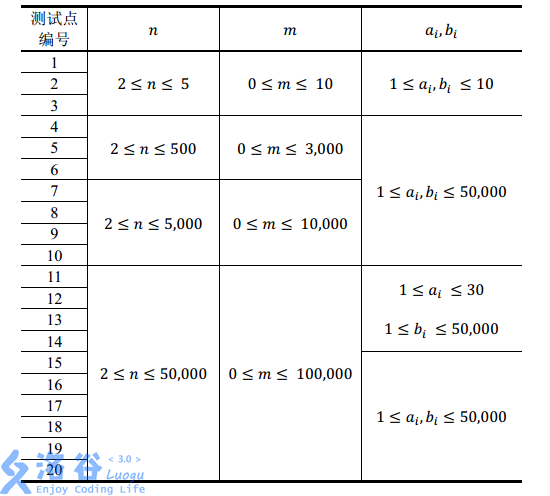(color{#0066ff}{ 题目描述 })
为了得到书法大家的真传,小 E 同学下定决心去拜访住在魔法森林中的隐 士。魔法森林可以被看成一个包含 n 个节点 m 条边的无向图,节点标号为 1,2,3,…,n,边标号为 1,2,3,…,m。初始时小 E 同学在 1 号节点,隐士则住在 n 号节点。小 E 需要通过这一片魔法森林,才能够拜访到隐士。
魔法森林中居住了一些妖怪。每当有人经过一条边的时候,这条边上的妖怪 就会对其发起攻击。幸运的是,在 1 号节点住着两种守护精灵:A 型守护精灵与 B 型守护精灵。小 E 可以借助它们的力量,达到自己的目的。
只要小 E 带上足够多的守护精灵,妖怪们就不会发起攻击了。具体来说,无 向图中的每一条边 ei 包含两个权值 ai 与 bi 。若身上携带的 A 型守护精灵个数不 少于 ai ,且 B 型守护精灵个数不少于 bi ,这条边上的妖怪就不会对通过这条边 的人发起攻击。当且仅当通过这片魔法森林的过程中没有任意一条边的妖怪向 小 E 发起攻击,他才能成功找到隐士。
由于携带守护精灵是一件非常麻烦的事,小 E 想要知道,要能够成功拜访到 隐士,最少需要携带守护精灵的总个数。守护精灵的总个数为 A 型守护精灵的 个数与 B 型守护精灵的个数之和。
(color{#0066ff}{输入格式})、
输入文件的第 1 行包含两个整数 n,m,表示无向图共有 n 个节点,m 条边。 接下来 m 行,第i+ 1 行包含 4 个正整数 Xi,Yi,ai,bi,描述第i条无向边。 其中Xi与 Yi为该边两个端点的标号,ai 与 bi 的含义如题所述。 注意数据中可能包含重边与自环。
(color{#0066ff}{输出格式})
输出一行一个整数:如果小 E 可以成功拜访到隐士,输出小 E 最少需要携 带的守护精灵的总个数;如果无论如何小 E 都无法拜访到隐士,输出“-1”(不 含引号)。
(color{#0066ff}{输入样例})
4 5
1 2 19 1
2 3 8 12
2 4 12 15
1 3 17 8
3 4 1 17
3 1
1 2 1 1
(color{#0066ff}{输出样例})
32
-1
(color{#0066ff}{数据范围与提示})
* 解释1
如果小 E 走路径 1→2→4,需要携带 19+15=34 个守护精灵; 如果小 E 走路径 1→3→4,需要携带 17+17=34 个守护精灵; 如果小 E 走路径 1→2→3→4,需要携带 19+17=36 个守护精灵; 如果小 E 走路径 1→3→2→4,需要携带 17+15=32 个守护精灵。 综上所述,小 E 最少需要携带 32 个守护精灵。
* 解释2
小 E 无法从 1 号节点到达 3 号节点,故输出-1。

(color{#0066ff}{ 题解 })
把所有边按a排序,用LCT维护边权为b的生成树(注意新加点使边权变成点权)
每次向内加边,a已知(已排序),把链上最大的b换下来,每次取min即可
#include<bits/stdc++.h>
#define LL long long
LL in() {
char ch; LL x = 0, f = 1;
while(!isdigit(ch = getchar()))(ch == '-') && (f = -f);
for(x = ch ^ 48; isdigit(ch = getchar()); x = (x << 1) + (x << 3) + (ch ^ 48));
return x * f;
}
const int maxn = 5e4 + 100;
const int inf = 0x7fffffff;
struct node {
int x, y, a, b;
friend bool operator < (const node &a, const node &b) { return a.a < b.a; }
}e[maxn << 1];
struct LCT {
protected:
struct node {
node *fa, *ch[2];
int max, val, rev;
node(int max = 0, int val = 0, int rev = 0): max(max), val(val), rev(rev) {}
void trn() { std::swap(ch[0], ch[1]); rev ^= 1; }
void upd() {
max = val;
if(ch[0]) max = std::max(max, ch[0]->max);
if(ch[1]) max = std::max(max, ch[1]->max);
}
void dwn() {
if(!rev) return;
if(ch[0]) ch[0]->trn();
if(ch[1]) ch[1]->trn();
rev = 0;
}
bool ntr() { return fa && (fa->ch[1] == this || fa->ch[0] == this); }
bool isr() { return this == fa->ch[1]; }
void clr() {
if(ch[0]) ch[0]->fa = NULL;
if(ch[1]) ch[1]->fa = NULL;
ch[0] = ch[1] = NULL;
}
}pool[maxn << 2];
void rot(node *x) {
node *y = x->fa, *z = y->fa;
bool k = x->isr(); node *w = x->ch[!k];
if(y->ntr()) z->ch[y->isr()] = x;
x->ch[!k] = y, y->ch[k] = w;
y->fa = x, x->fa = z;
if(w) w->fa = y;
y->upd(), x->upd();
}
void splay(node *o) {
static node *st[maxn << 2];
int top;
st[top = 1] = o;
while(st[top]->ntr()) st[top + 1] = st[top]->fa, top++;
while(top) st[top--]->dwn();
while(o->ntr()) {
if(o->fa->ntr()) rot(o->isr() ^ o->fa->isr()? o : o->fa);
rot(o);
}
}
void access(node *x) {
for(node *y = NULL; x; x = (y = x)->fa)
splay(x), x->ch[1] = y, x->upd();
}
void makeroot(node *x) { access(x), splay(x), x->trn(); }
node *findroot(node *x) {
access(x), splay(x);
while(x->dwn(), x->ch[0]) x = x->ch[0];
return x;
}
void link(node *x, node *y) { makeroot(x), x->fa = y; }
node *findpos(node *x, int max) {
while(x->dwn(), x->val != max) {
if(x->ch[0] && x->ch[0]->max == max) x = x->ch[0];
else x = x->ch[1];
}
return x;
}
public:
void init(::node *a,int n, int m) {
for(int i = n + 1; i <= n + m; i++)
pool[i].val = a[i - n].b, pool[i].upd();
}
void add(const ::node &a, int id) {
node *x = pool + a.x, *y = pool + a.y;
node *o = pool + id;
if(findroot(x) == findroot(y)) {
makeroot(x), access(y), splay(y);
if(a.b >= y->max) return;
node *d = findpos(y, y->max);
splay(d);
d->clr(), d->upd();
}
link(x, o), link(o, y);
}
int query(int l, int r) {
node *x = pool + l, *y = pool + r;
if(findroot(x) != findroot(y)) return -1;
makeroot(x), access(y), splay(y);
return y->max;
}
}s;
int n, m, ans = inf;
int main() {
n = in(), m = in();
for(int i = 1; i <= m; i++)
e[i].x = in(), e[i].y = in(), e[i].a = in(), e[i].b = in();
std::sort(e + 1, e + m + 1);
s.init(e, n, m);
for(int i = 1; i <= m; i++) {
s.add(e[i], i + n);
int v = s.query(1, n);
if(v == -1) continue;
ans = std::min(ans, v + e[i].a);
}
printf("%d", ans == inf? -1 : ans);
return 0;
}